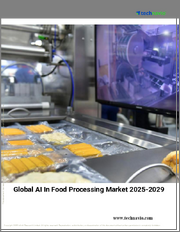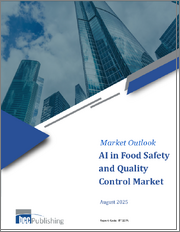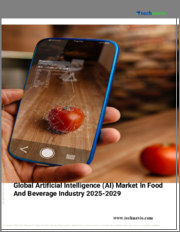
|
시장보고서
상품코드
1635979
식품 및 음료용 인공지능(AI) 시장 보고서 : 용도별, 최종 용도별, 지역별(2025-2033년)Artificial Intelligence in Food & Beverages Market Report by Application, End Use, and Region 2025-2033 |
||||||
세계 식품 및 음료용 인공지능(AI) 시장 규모는 2024년 100억 달러에 달했습니다. 향후 IMARC Group은 2033년까지 시장 규모가 1,158억 달러에 달할 것으로 예상하며, 2025년부터 2033년까지 31.34%의 연평균 성장률(CAGR)을 기록할 것으로 전망하고 있습니다. 식음료(F&B) 인프라의 대폭적인 개선, 공급망 운영 효율화에 대한 요구 증가, 자동화 서비스의 보급 등이 시장 성장을 촉진하는 요인으로 작용하고 있습니다.
인공지능(AI)은 컴퓨터 과학의 한 분야로, 프로그래밍된 로봇 기계에 인간의 지능을 시뮬레이션하여 일반적으로 인간의 개입이 필요한 다양한 산업 작업을 수행할 수 있도록 하는 것을 목표로 합니다. 현재 식음료(F&B) 분야에서는 품질 관리, 식사 운송, 소비자 응대, 산업 표준 준수, 제품 및 포장, 식품 선별 애플리케이션을 실행하는 데 사용되고 있습니다. 이러한 서비스는 우수한 위생 기준을 유지하고, 일부 음료 및 식품의 최적의 품질을 보장하고, 영양가를 유지하고, 미생물을 감지하고, 적시에 배송을 보장하고, 과잉 생산을 최소화하여 낭비를 줄이는 데 도움이 됩니다. 이 외에도 워크플로우를 최적화하고, 작업자의 부담을 줄이며, 소비자 추천에 기반한 신제품 혁신을 가능하게 하고, 구매 경험을 향상시킵니다. 그 결과, 식음료용 AI는 물류, 인적 오류 방지, 더 나은 비즈니스 관련 의사결정을 위해 광범위하게 활용되고 있습니다.
식품 및 음료용 인공지능(AI) 시장 동향:
식음료(F&B) 인프라의 대폭적인 개선은 시장 성장을 촉진하는 주요 요인입니다. 또한, 공급망 운영 효율성 향상에 대한 수요 증가와 다양한 식음료를 선별하는 자동화 서비스의 보급이 시장 성장을 뒷받침하고 있습니다. 또한, 호텔, 레스토랑, 케이터링(HoReCa) 부문의 급속한 성장과 퀵 서비스 레스토랑(QSR)의 최근 설립은 식음료용 AI 유닛에 대한 수요를 촉진하고 있으며, 이는 또 다른 성장 촉진요인으로 작용하고 있습니다. 이러한 솔루션은 매출 예측, 고객 행동 분석, 모니터링 및 추론을 지원하여 귀중한 소비자 인사이트를 확보하여 보다 타겟팅된 노력을 기울이고, 더 깊은 상호 작용을 통해 개인 수준의 연결을 만들어 전반적인 고객 경험을 향상시킵니다. 또한, 재고 수준을 예측하여 목재 낭비를 줄이고, 제품 수량을 모니터링하고, 생산 주기 시간을 감지하고, 운영 비용을 절감하면서 기계 가동 중단 시간을 최소화하기 위해 식품 및 음료용 AI를 광범위하게 도입하여 시장 성장을 지원하고 있습니다. 이와 함께 식품 생산 절차와 머신러닝(ML) 솔루션의 통합 측면에서 상당한 기술 발전이 시장 성장을 주도하고 있습니다. 이러한 솔루션은 최종 목표를 추측하고, 시장 전략을 개선하고, 창고 관리 비용을 줄이기 위해 견적에서 모든 세부 사항을 기록하기 위해 광범위하게 배포되고 있습니다. 이와는 별도로 주요 기업 간의 지속적인 현대화 및 전략적 제휴가 시장 성장에 긍정적인 영향을 미치고 있습니다.
본 보고서에서 다루는 주요 질문
- 식품 및 음료용 인공지능(AI) 시장은 지금까지 어떻게 성장해왔으며, 향후 몇 년 동안 어떻게 변화할 것인가?
- 세계 식품 및 음료용 인공지능(AI) 시장의 촉진요인, 저해요인, 기회요인은 무엇일까?
- 주요 지역 시장은?
- 식품 및 음료용 인공지능(AI) 시장에서 가장 매력적인 국가는 어디일까?
- 용도별 시장 분석은?
- 최종 용도별 시장 분석은?
- 세계 식품 및 음료용 인공지능(AI) 시장의 경쟁 구도는?
- 세계 식품 및 음료용 인공지능(AI) 시장의 주요 플레이어/기업은?
목차
제1장 서문
제2장 조사 범위와 조사 방법
- 조사 목적
- 이해관계자
- 데이터 소스
- 1차 정보
- 2차 정보
- 시장 추정
- 상향식 접근
- 하향식 접근
- 조사 방법
제3장 주요 요약
제4장 소개
- 개요
- 주요 업계 동향
제5장 세계의 식품 및 음료용 인공지능(AI) 시장
- 시장 개요
- 시장 실적
- COVID-19의 영향
- 시장 예측
제6장 시장 내역 : 용도별
- 식품 선별
- 시장 동향
- 시장 예측
- 품질 관리와 안전 컴플라이언스
- 시장 동향
- 시장 예측
- 소비자 참여
- 시장 동향
- 시장 예측
- 생산과 포장
- 시장 동향
- 시장 예측
- 유지보수
- 시장 동향
- 시장 예측
- 기타
- 시장 동향
- 시장 예측
제7장 시장 내역 : 최종 용도별
- 식품 가공 산업
- 시장 동향
- 시장 예측
- 호텔과 레스토랑
- 시장 동향
- 시장 예측
- 음료 업계
- 시장 동향
- 시장 예측
제8장 시장 내역 : 지역별
- 북미
- 미국
- 캐나다
- 아시아태평양
- 중국
- 일본
- 인도
- 한국
- 호주
- 인도네시아
- 기타
- 유럽
- 독일
- 프랑스
- 영국
- 이탈리아
- 스페인
- 러시아
- 기타
- 라틴아메리카
- 브라질
- 멕시코
- 기타
- 중동 및 아프리카
제9장 촉진요인, 억제요인, 기회
- 개요
- 성장 촉진요인
- 성장 억제요인
- 기회
제10장 밸류체인 분석
제11장 Porter's Five Forces 분석
- 개요
- 구매자의 교섭력
- 공급 기업의 교섭력
- 경쟁 정도
- 신규 참여업체의 위협
- 대체품의 위협
제12장 가격 분석
제13장 경쟁 구도
- 시장 구조
- 주요 기업
- 주요 기업 개요
- ABB Ltd.
- Sesotec GmbH
- Siemens AG
- Sight Machine
- TOMRA System ASA
The global artificial intelligence (AI) in food & beverages market size reached USD 10.0 Billion in 2024. Looking forward, IMARC Group expects the market to reach USD 115.8 Billion by 2033, exhibiting a growth rate (CAGR) of 31.34% during 2025-2033. The significant improvements in the food and beverage (F&B) infrastructure, the increasing need to improve supply chain operational efficiency and the widespread adoption of automated services are some factors driving the market growth.
Artificial intelligence (AI) represents a branch of computer science concerned with the simulation of human intelligence in programmed robotic machines to make them capable of performing various industrial operations, which usually require human intervention. It is currently employed in the food and beverage (F&B) sector to execute quality control, meal transportation, consumer engagement, industrial standard compliance, product and packaging, and food sorting applications. These services help maintain excellent hygiene standards, ensure the optimal quality of several drinks and food products, retain their nutritional value, detect microorganisms, and reduce wastage by ensuring timely delivery and minimizing overproduction. Apart from this, it optimizes workflow, reduces workload from workers, allows innovation of new products based on consumer recommendations, and enhances purchasing experience. As a result, AI in food and beverage units is extensively used for logistics, preventing human errors, and making better business-related decisions.
Artificial Intelligence (AI) in Food & Beverages Market Trends:
The significant improvements in the food and beverage (F&B) infrastructure represent a prime factor driving the market growth. This is further supported by the increasing need to improve supply chain operational efficiency and the widespread adoption of automated services to sort diverse food and beverage products. Additionally, the rapid expansion in the hotels, restaurants, and catering (HoReCa) sector and the recent establishment of quick service restaurants (QSRs) have facilitated the demand for AI in food beverage units, which is acting as another growth-inducing factor. These solutions help predict sales, analyze, monitor, and deduce customer behavior, and gain valuable consumer insights to make more targeted efforts, create personal level connections through deeper interactions and improve the overall customer experience. Furthermore, the extensive uptake of AI in food beverage to forecast inventory levels to decrease wood wastage, monitor product quantities, detect production cycle time and minimize machine downtime at reduced operational expenses is supporting the market growth. In line with this, the significant technological advancements in terms of food production procedures and the integration of machine learning (ML) solutions are propelling the market growth. They are widely deployed to deduce end goals, refine market strategies, and record every detail from quotations to reduce warehousing costs. Apart from this, the continuous modernization and strategic collaborations amongst key players are positively impacting the market growth.
Key Market Segmentation:
Application Insights:
- Food Sorting
- Quality Control and Safety Compliance
- Consumer Engagement
- Production and Packaging
- Maintenance
- Others
- The report has also provided a detailed breakup and analysis of artificial intelligence (AI) in food & beverages market based on the application. This includes food sorting, quality control and safety compliance, consumer engagement, production and packaging, maintenance, and others. According to the report, consumer engagement represented the largest segment.
End Use Insights:
- Food Processing Industry
- Hotel and Restaurant
- Beverage Industry
Regional Insights:
- North America
- United States
- Canada
- Asia-Pacific
- China
- Japan
- India
- South Korea
- Australia
- Indonesia
- Others
- Europe
- Germany
- France
- United Kingdom
- Italy
- Spain
- Russia
- Others
- Latin America
- Brazil
- Mexico
- Others
- Middle East and Africa
- The report has also provided a comprehensive analysis of all the major regional markets that include North America (the United States and Canada); Asia Pacific (China, Japan, India, South Korea, Australia, Indonesia, and others); Europe (Germany, France, the United Kingdom, Italy, Spain, Russia, and others); Latin America (Brazil, Mexico, and others); and the Middle East and Africa. According to the report, North America was the largest market for artificial intelligence (AI) in food & beverages. Some of the factors driving the North America artificial intelligence (AI) in food & beverages included extensive research and development (R&D) activities, significant technological advancements, and rapid expansion in the food and beverage (F&B) sector.
Competitive Landscape:
- The report has also provided a comprehensive analysis of the competitive landscape in the global artificial intelligence (AI) in food & beverages market. Detailed profiles of all major companies have also been provided. Some of the companies covered include ABB Ltd., Sesotec GmbH, Siemens AG, Sight Machine, TOMRA System ASA, etc.
Key Questions Answered in This Report:
- How has the global artificial intelligence (AI) in the food beverages market performed so far, and how will it perform in the coming years?
- What are the drivers, restraints, and opportunities in the global artificial intelligence (AI) in food & beverages market?
- What are the key regional markets?
- Which countries represent the most attractive artificial intelligence (AI) in food & beverages markets?
- What is the breakup of the market based on the application?
- What is the breakup of the market based on the end use?
- What is the competitive structure of the global artificial intelligence (AI) in food & beverages market?
- Who are the key players/companies in the global artificial intelligence (AI) in food & beverages market?
Table of Contents
1 Preface
2 Scope and Methodology
- 2.1 Objectives of the Study
- 2.2 Stakeholders
- 2.3 Data Sources
- 2.3.1 Primary Sources
- 2.3.2 Secondary Sources
- 2.4 Market Estimation
- 2.4.1 Bottom-Up Approach
- 2.4.2 Top-Down Approach
- 2.5 Forecasting Methodology
3 Executive Summary
4 Introduction
- 4.1 Overview
- 4.2 Key Industry Trends
5 Global Artificial Intelligence (AI) in Food & Beverages Market
- 5.1 Market Overview
- 5.2 Market Performance
- 5.3 Impact of COVID-19
- 5.4 Market Forecast
6 Market Breakup by Application
- 6.1 Food Sorting
- 6.1.1 Market Trends
- 6.1.2 Market Forecast
- 6.2 Quality Control and Safety Compliance
- 6.2.1 Market Trends
- 6.2.2 Market Forecast
- 6.3 Consumer Engagement
- 6.3.1 Market Trends
- 6.3.2 Market Forecast
- 6.4 Production and Packaging
- 6.4.1 Market Trends
- 6.4.2 Market Forecast
- 6.5 Maintenance
- 6.5.1 Market Trends
- 6.5.2 Market Forecast
- 6.6 Others
- 6.6.1 Market Trends
- 6.6.2 Market Forecast
7 Market Breakup by End Use
- 7.1 Food Processing Industry
- 7.1.1 Market Trends
- 7.1.2 Market Forecast
- 7.2 Hotel and Restaurant
- 7.2.1 Market Trends
- 7.2.2 Market Forecast
- 7.3 Beverage Industry
- 7.3.1 Market Trends
- 7.3.2 Market Forecast
8 Market Breakup by Region
- 8.1 North America
- 8.1.1 United States
- 8.1.1.1 Market Trends
- 8.1.1.2 Market Forecast
- 8.1.2 Canada
- 8.1.2.1 Market Trends
- 8.1.2.2 Market Forecast
- 8.1.1 United States
- 8.2 Asia-Pacific
- 8.2.1 China
- 8.2.1.1 Market Trends
- 8.2.1.2 Market Forecast
- 8.2.2 Japan
- 8.2.2.1 Market Trends
- 8.2.2.2 Market Forecast
- 8.2.3 India
- 8.2.3.1 Market Trends
- 8.2.3.2 Market Forecast
- 8.2.4 South Korea
- 8.2.4.1 Market Trends
- 8.2.4.2 Market Forecast
- 8.2.5 Australia
- 8.2.5.1 Market Trends
- 8.2.5.2 Market Forecast
- 8.2.6 Indonesia
- 8.2.6.1 Market Trends
- 8.2.6.2 Market Forecast
- 8.2.7 Others
- 8.2.7.1 Market Trends
- 8.2.7.2 Market Forecast
- 8.2.1 China
- 8.3 Europe
- 8.3.1 Germany
- 8.3.1.1 Market Trends
- 8.3.1.2 Market Forecast
- 8.3.2 France
- 8.3.2.1 Market Trends
- 8.3.2.2 Market Forecast
- 8.3.3 United Kingdom
- 8.3.3.1 Market Trends
- 8.3.3.2 Market Forecast
- 8.3.4 Italy
- 8.3.4.1 Market Trends
- 8.3.4.2 Market Forecast
- 8.3.5 Spain
- 8.3.5.1 Market Trends
- 8.3.5.2 Market Forecast
- 8.3.6 Russia
- 8.3.6.1 Market Trends
- 8.3.6.2 Market Forecast
- 8.3.7 Others
- 8.3.7.1 Market Trends
- 8.3.7.2 Market Forecast
- 8.3.1 Germany
- 8.4 Latin America
- 8.4.1 Brazil
- 8.4.1.1 Market Trends
- 8.4.1.2 Market Forecast
- 8.4.2 Mexico
- 8.4.2.1 Market Trends
- 8.4.2.2 Market Forecast
- 8.4.3 Others
- 8.4.3.1 Market Trends
- 8.4.3.2 Market Forecast
- 8.4.1 Brazil
- 8.5 Middle East and Africa
- 8.5.1 Market Trends
- 8.5.2 Market Breakup by Country
- 8.5.3 Market Forecast
9 Drivers, Restraints, and Opportunities
- 9.1 Overview
- 9.2 Drivers
- 9.3 Restraints
- 9.4 Opportunities
10 Value Chain Analysis
11 Porters Five Forces Analysis
- 11.1 Overview
- 11.2 Bargaining Power of Buyers
- 11.3 Bargaining Power of Suppliers
- 11.4 Degree of Competition
- 11.5 Threat of New Entrants
- 11.6 Threat of Substitutes
12 Price Analysis
13 Competitive Landscape
- 13.1 Market Structure
- 13.2 Key Players
- 13.3 Profiles of Key Players
- 13.3.1 ABB Ltd.
- 13.3.1.1 Company Overview
- 13.3.1.2 Product Portfolio
- 13.3.1.3 Financials
- 13.3.1.4 SWOT Analysis
- 13.3.2 Sesotec GmbH
- 13.3.2.1 Company Overview
- 13.3.2.2 Product Portfolio
- 13.3.3 Siemens AG
- 13.3.3.1 Company Overview
- 13.3.3.2 Product Portfolio
- 13.3.3.3 Financials
- 13.3.3.4 SWOT Analysis
- 13.3.4 Sight Machine
- 13.3.4.1 Company Overview
- 13.3.4.2 Product Portfolio
- 13.3.5 TOMRA System ASA
- 13.3.5.1 Company Overview
- 13.3.5.2 Product Portfolio
- 13.3.5.3 Financials
- 13.3.1 ABB Ltd.
Kindly note that this only represents a partial list of companies, and the complete list has been provided in the report.











